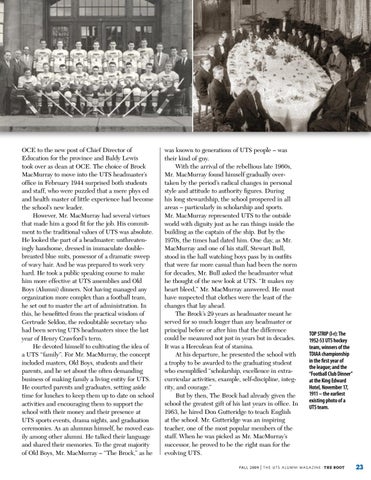OCE to the new post of Chief Director of Education for the province and Baldy Lewis took over as dean at OCE. The choice of Brock MacMurray to move into the UTS headmaster’s office in February 1944 surprised both students and staff, who were puzzled that a mere phys ed and health master of little experience had become the school’s new leader. However, Mr. MacMurray had several virtues that made him a good fit for the job. His commitment to the traditional values of UTS was absolute. He looked the part of a headmaster: unthreateningly handsome, dressed in immaculate doublebreasted blue suits, possessor of a dramatic sweep of wavy hair. And he was prepared to work very hard. He took a public speaking course to make him more effective at UTS assemblies and Old Boys (Alumni) dinners. Not having managed any organization more complex than a football team, he set out to master the art of administration. In this, he benefitted from the practical wisdom of Gertrude Seldon, the redoubtable secretary who had been serving UTS headmasters since the last year of Henry Crawford’s term. He devoted himself to cultivating the idea of a UTS “family”. For Mr. MacMurray, the concept included masters, Old Boys, students and their parents, and he set about the often demanding business of making family a living entity for UTS. He courted parents and graduates, setting aside time for lunches to keep them up to date on school activities and encouraging them to support the school with their money and their presence at UTS sports events, drama nights, and graduation ceremonies. As an alumnus himself, he moved easily among other alumni. He talked their language and shared their memories. To the great majority of Old Boys, Mr. MacMurray – “The Brock,” as he
was known to generations of UTS people – was their kind of guy. With the arrival of the rebellious late 1960s, Mr. MacMurray found himself gradually overtaken by the period’s radical changes in personal style and attitude to authority figures. During his long stewardship, the school prospered in all areas – particularly in scholarship and sports. Mr. MacMurray represented UTS to the outside world with dignity just as he ran things inside the building as the captain of the ship. But by the 1970s, the times had dated him. One day, as Mr. MacMurray and one of his staff, Stewart Bull, stood in the hall watching boys pass by in outfits that were far more casual than had been the norm for decades, Mr. Bull asked the headmaster what he thought of the new look at UTS. “It makes my heart bleed,” Mr. MacMurray answered. He must have suspected that clothes were the least of the changes that lay ahead. The Brock’s 29 years as headmaster meant he served for so much longer than any headmaster or principal before or after him that the difference could be measured not just in years but in decades. It was a Herculean feat of stamina. At his departure, he presented the school with a trophy to be awarded to the graduating student who exemplified “scholarship, excellence in extracurricular activities, example, self-discipline, integrity, and courage.” But by then, The Brock had already given the school the greatest gift of his last years in office. In 1963, he hired Don Gutteridge to teach English at the school. Mr. Gutteridge was an inspiring teacher, one of the most popular members of the staff. When he was picked as Mr. MacMurray’s successor, he proved to be the right man for the evolving UTS.
fa l l 2009
|
TOP STRIP (l-r): The 1952-53 UTS hockey team, winners of the TDIAA championship in the first year of the league; and the “Football Club Dinner” at the King Edward Hotel, November 17, 1911 – the earliest existing photo of a UTS team.
t h e u t s a l u m n i m a g a z i n e : t he root
23
